7 Common Shower Pan Sizes: Listed & Explained
Author: Omar Alonso | Editor: Omar Alonso
Review & Research: Jen Worst & Chris Miller
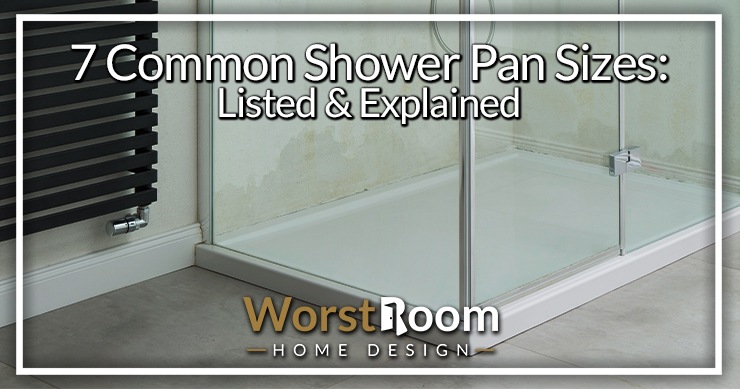
If you’re remodeling a bathroom or repairing your shower, you have to choose a shower pan. While the shower pan sizes are many, you don't need to worry as the size of your bathroom and the area designated for the shower will dictate what size pans will work for you.
Most people focus on the fun stuff, like tile colors and faucet styles, but you need the right shower pan if you want a comfortable and functional shower. But what size shower pan is appropriate for you? Consider this your complete guide to shower pan sizes.
What Is a Shower Pan?
A shower pan is a single, solid piece insert that acts as the floor or foundation for a shower. The many types of shower pans can be made from various materials and can have tile or another material laid on top. In most bathrooms, you are standing on the pan while you shower.
The Importance of Shower Pans
You may be asking yourself, do I need a shower pan? Some showers are installed without a shower pan, however, it’s best to use it for several reasons.
- A shower pan provides a waterproof surface for tile and other materials
- Shower pans protect your floor and subfloor from leaks
- Shower pans can redirect water away from the grout and toward the drain
- A shower pan can also protect drywall, paint, furniture, and other items in your bathroom
- Shower pans reduce the likelihood of mold infestations and wood rot
Shower pans protect your bathroom, home, and belongings. Ideally, every shower should have a shower pan to prevent leaks, bacteria, and structural damage.
Shower Pan vs. Shower Base
The shower pan and shower base are very similar and can be interchangeable. A shower pan typically sits on top of a shower base. However, in showers where people lay tile or ceramic over their shower pan, they may not use a shower base. The pre-fabricated shower base sizes will match the pan sizes listed below.
Shower pans are more attractive and solid, while shower bases are cement or mortar. As mentioned, people interchange the terms, but all you need to know for this article is the shower product discussed here is a single piece of solid material.
7 Most Popular Shower Pan Sizes
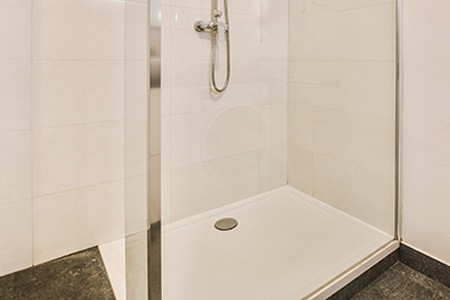
The sections below will dive deeper into shower pan size options and possibilities. You can read about the different dimensions and understand the various measurements involved.
But to give you an idea of the most popular shower pan sizes, below are the top seven listed in order of popularity. You could almost consider them the standard shower pan sizes available.
- 60 x 32 inches
- 60 x 30 inches
- 60 x 36 inches
- 60 x 34 inches
- 36 x 36 inches
- 48 x 36 inches
- 48 x 32 inches
Shower pans sizes can sometimes be described as:
- Standard
- Corner
- Rectangular
- Walk-in
- Small
- Bathtub
Become familiar with this nomenclature so you can match them to their dimensions and make a more informed decision. Which you choose will be dictated by your toilet room dimensions, so it's not as complicated as you might think, so don't get overwhelmed!
Common Shower Pan Sizes Explained
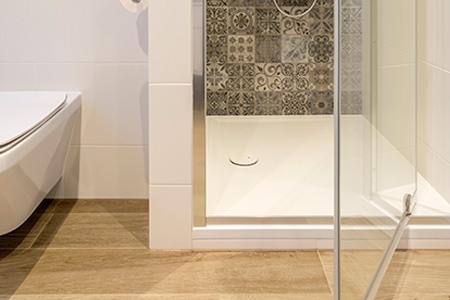
Shower pans are often customizable, so you can likely order a shower pan in any size you want. They are typically no bigger than 60 inches all the way around and no smaller than 28 inches. This section will break down the most common shower pan size by width, length, and height.
Width
The width of the shower pan is typically the longer side or the side where the opening of the shower is. The top brands that produce shower pans use an average width of 60 inches. This size is the most popular and suitable for most standing showers.
In summary, below are the most common shower pan width sizes:
- 36 inches
- 38 inches
- 42 inches
- 48 inches
- 60 inches (most popular)
Interestingly, 60 inches is the largest width option from most brands, so it’s likely the most popular because people like roomier showers to make washing more comfortable. The smallest width is around 28 inches.
Length
Many standing showers are squares, so the length will often match the width. But rectangular showers are becoming more popular, as people want as much room in the shower as possible. The length is typically the shorter side, so showers are considered wider than they are long.
Below is an overview of the most common shower pan lengths:
- 30 inches
- 32 inches
- 34 inches
- 36 inches (most popular)
- 42 inches
- 48 inches
The most popular shower pan length is 36 inches, with 32 inches being a closer runner-up. The least common shower pan size is 48 inches, which may be surprising. The reason the width is sometimes larger than the length is to accommodate the bathroom's size and shape. A rectangular shower can fit more snugly into many bathrooms.
Height
The height of a shower pan, meaning the difference between the sides and the center, does not usually range substantially. The highest height is usually around 3 inches and the shortest height is around 0.75 inches.
The lower the height, the more likely your shower may overfill, spilling water onto your floor. In a perfect world, your shower drain works impeccably and you’ll never encounter this problem. But since you live in this world, consider choosing a pan with a higher height to prevent a mini flood.
Other Shower Pan Dimensions to Consider
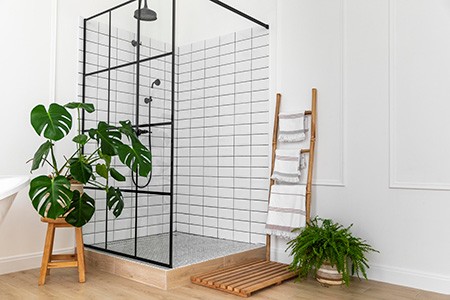
Aside from width, length, and height, there are a few other minor measurements to consider when selecting a shower pan.
Slope Height: Sloped showers are a popular style and the size of the slope matters. Slope heights range from zero inches to three inches.
Threshold Thickness: The threshold thickness is the width of your shower’s curb. The lip that you step over, which determines the depth, can be thick, creating a ledge, or thin, creating more of a wall. Threshold thickness ranges from 0.5 inches to four inches. Thresholds can be curbed, traditional, or beveled.
Distance from Drain Center: For aesthetic and comfort purposes, this measurement is not very important. However, it’s necessary for plumbers and installers. The measurement can range substantially, from one inch to 30 inches.
ADA Compliant Shower Pan Sizes
The measurements mentioned above apply to standard shower sizes. But ADA-compliant showers that are more accessible or differently accessible can have very different measurements.
For example, the height of the shower may be zero, making it wheelchair accessible. Many shower pans that meet ADA requirements are custom-made.
How to Choose the Right Shower Pan Size
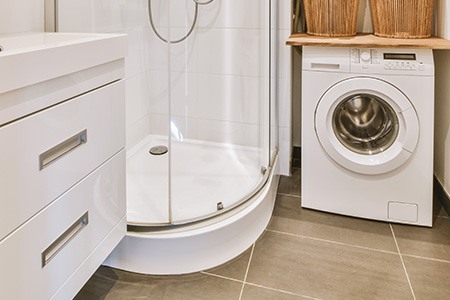
If you’re replacing a shower pan in an existing shower, you don’t have much choice; you have to buy a shower pan with the same dimensions.
But when building a new bathroom from scratch, you have more options! Below are some considerations to help you choose the perfect choice among the standard shower base sizes for your beautiful new bathroom.
Bathroom Size
The top consideration is the space you have in your bathroom. If you have a large bathroom, you can choose whatever size you want, and most people prefer the largest size possible so they can shower with plenty of room.
Bathroom Shape
The bathroom's shape can help you choose your shower pan dimensions. Many people like a square shower in a rectangular bathroom and vice versa, as it adds depth to the room and creates a pleasant design.
Bathroom Budget
The larger the shower pan, the more it usually costs. If you're remodeling your bathroom on a tight budget, consider one of the small pan sizes and try to choose readily available sizes. Custom sizes cost much more.
Frequently Asked Questions Concerning Shower Pans
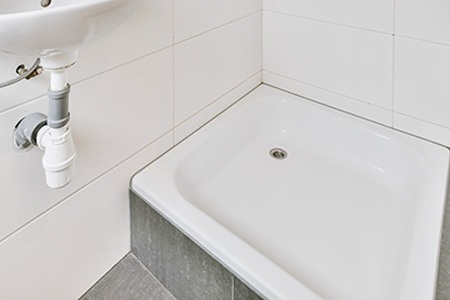
Below are some helpful answers to commonly asked questions related to shower pans.
How Much Does a Shower Pan Cost?
The size and material heavily impact the cost. But on average, people pay $250. The cost can range from $150 to $800.
Is There an Alternative to a Shower Pan?
Yes, if you don’t want to purchase and install a shower pan, you can opt for a ceramic floor instead. The ceramic or tile floor can be laid at the bottom of your shower and function the same way as a shower pan. Laying a ceramic or tile floor creates a walk-in shower setup, which is more modern and sleek.
What Materials are Best for Shower Pans?
Shower pans can come in various materials, such as ceramic, acrylic, metal, tile, fiberglass, stone, lead, vinyl, or porcelain.
Do Bathtubs Have Pans?
Technically, the bathtub is its own pan. Combination showers, meaning setups where the shower is in a bathtub, do not require a shower pan. The bathtub protects the floor from water and takes over the role of the shower pan.
Those are Your Common Shower Pan Sizes
For most people, bigger is better when it comes to their showers. So people prefer sizes like 60 by 32 inches, and 60 by 30 inches, but not every bathroom can accommodate a large shower. Hopefully, this article gives you an idea of the right shower pan sizes for your bathrooms.



